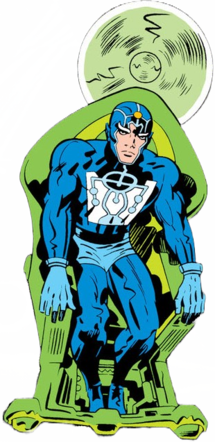Fictional character biography
Although he possesses the powers of a god, Metron is typically depicted as a passive observer in the DC Universe rather than an active participant. He wanders in search of greater knowledge beyond his own, riding on his Mobius Chair, [3] which can traverse time and space instantaneously. Metron is of neither New Genesis nor Apokolips, and usually avoids the struggle between the two worlds. Metron invented the "Boom Tube" technology used by the New Gods to teleport vast distances. [4]
In 1989's Legends mini-series, Metron confides in Darkseid about the Anti-Life Equation. Apparently, Metron holds the key to the Anti-Life Equation. However, he is a seeker of knowledge, therefore he will tell no one of his knowledge. In the 1982 DC/Marvel crossover The Uncanny X-Men and The New Teen Titans , Metron tells Darkseid that Dark Phoenix is a part of the Anti-Life Equation. In the 2007 "Death of the New Gods" miniseries leading into Final Crisis , the Source explains the origin of the Anti-Life Equation to Metron.
Metron helps contact most of Earth's superheroes to gather them during the Zero Hour crisis. During Extant's return, he battles alongside the Justice Society of America after Extant gains control of the omnipotent Worlogog.
In Kurt Busiek's JLA/Avengers miniseries, Metron observes the events in that story, and gives Iron Man a Mother Box to balance the power given to the Justice League by Grandmaster. He observes and investigates Krona's actions, refusing to deviate from his non-involvement at the end when Krona demanded his aid. At the end, Metron watches over the newly formed cosmic egg.
In Mister Miracle , Metron contacts Mister Miracle during a stunt gone wrong, making him aware of the Fourth World. In his first appearance in the book, he looks like he has before, but later he disguises himself as an epileptic man in a wheelchair.
During the events of Death of the New Gods , where the mysterious deaths of the entire Fourth World accelerated, Metron learns that the murderer is the Source, who has been trying to reacquire its original powers and reunite with its other half: the Anti-Life Entity. Rather than stop the Source, Metron stands by the Source's side to watch as the Fourth World comes to an end. After the death of Mister Miracle at the hands of the Source, Metron grows disgusted and demands to be killed, with the Source complies with. [5] Superman later uses Metron's Mobius Chair to gain the precious Element X needed to power up the Miracle Machine enough to restore the multiverse and undo all damages brought by Darkseid. It is revealed that Metron and every other denizen of Apokolips and New Genesis, except for Darkseid, is fated to be reborn. [6]
The New 52
In 2011, The New 52 rebooted the DC universe. Metron consults with Highfather about the various uses of the Lantern rings. About twenty members of the interstellar police force, the Green Lantern Corps confront Highfather and his military forces. They are trying to recover the power ring belonging to the sentient planet Mogo, who needs it to remain sentient and viable. Highfather leaves the matter to his subordinates, who slaughter most of the Lanterns. [7]
Metron confronts the Anti-Monitor on Earth-Three an attempt to divert a war between the Anti-Monitor and Darkseid. A conversation between Metron and the Anti-Monitor suggests that he once sat on the Mobius Chair himself prior to Metron. Metron is struck from behind by Darkseid's daughter Grail, who leaves him for dead. [8]
Metron returns to confront the Justice League and warn them that they should evacuate Earth, as it is impossible to win against the Anti-Monitor and Darkseid. Diana uses the Lasso of Truth to make Metron admit that they can find the answers if they take the chair from him, prompting Diana to pull him off the chair and Batman to sit in it, giving him access to all of Metron's accumulated knowledge. [9]
After the Anti-Monitor and Darkseid are destroyed in battle, Metron appears on the moon and trains Owlman, who now controls the Mobius Chair. As Owlman demands to know the secrets of the universe, he and Metron are vaporized by a mysterious entity. [10]
During the "Dark Nights: Death Metal" storyline, an omniversal being called the Chronicler watches the battle between Perpetua and the Darkest Knight. The Chronicler resurrects Metron, who notes that they have similar motives in life, like wanting to observe and save the multiverse. Metron allows the Chronicler to look into his mind. [11]
This page is based on this
Wikipedia article Text is available under the
CC BY-SA 4.0 license; additional terms may apply.
Images, videos and audio are available under their respective licenses.
